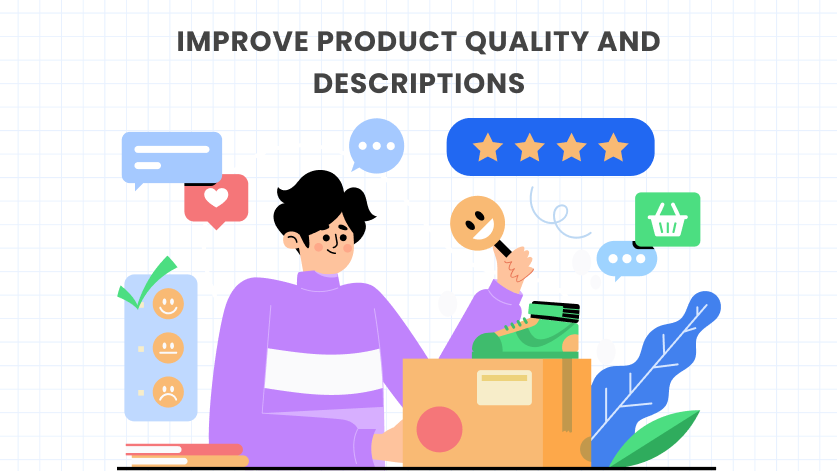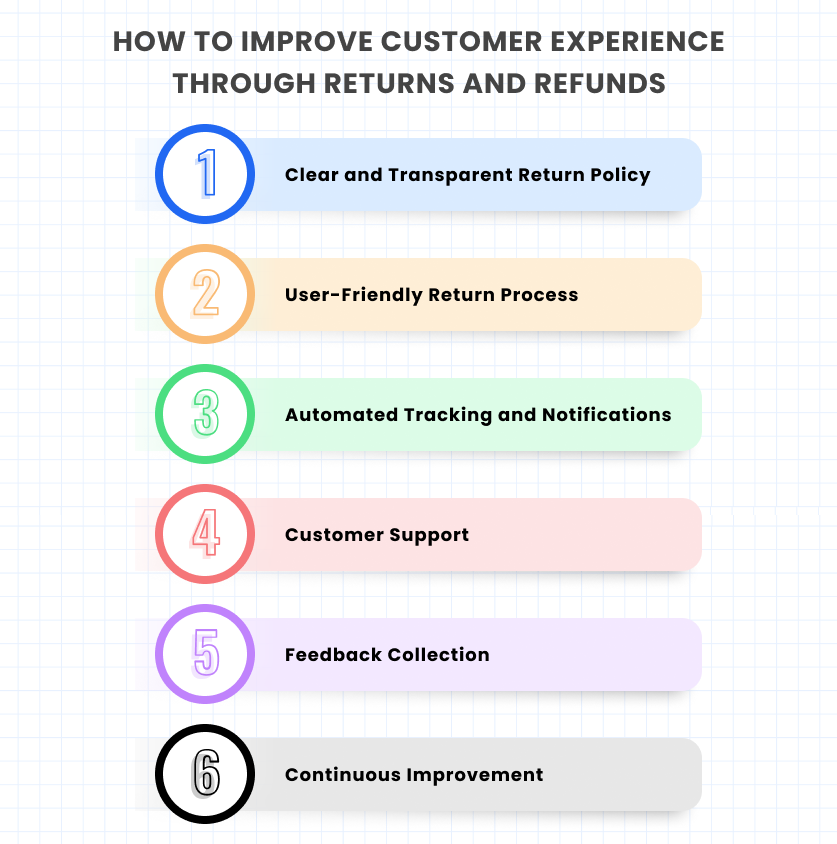Returns and refunds are an inevitable part of running a business. No matter how great your products or services are, there will always be customers who are dissatisfied or need to return an item for various reasons.
As a Shopify merchant, it’s important to have a clear and efficient process in place for handling returns and refunds.
Returns and refunds can be difficult to navigate, and how well you manage them can make or break your reputation in the online marketplace.
Recognizing the importance of handling return and refund processes is critical in this dynamic scenario, where customer expectations require seamless solutions.
In this comprehensive guide, we’ll cover everything you need to know about handling returns and refunds for your online business.
Why Are Returns and Refunds Important?
Returns and refunds are important for several reasons:
- They help maintain customer satisfaction and loyalty.
- They can improve your brand’s reputation.
- They can provide valuable feedback for product or service improvements.
- They are required by law in many countries.
Understanding Return Policies:
Before we dive into the process of handling returns and refunds, it’s important to have a clear understanding of your return policy.
Your return policy should outline the conditions under which customers can return items, the timeframe for returns, and any other important details.
Your return policy should be easily accessible and clearly stated on your website, in-store, or on your product packaging. This will help manage customer expectations and avoid any confusion or disputes.
The Importance of Tracking Refund Status:
Tracking the status of refunds is crucial for both the customer and the business. Customers want to know when they can expect to receive their refund, and businesses need to keep track of their finances and inventory.
Having a system in place to track refund status can also help identify any issues or delays in the process, allowing you to address them promptly and maintain customer satisfaction.
Understanding the Impact of Returns and Refunds on Online Business:
Returns and refunds are a part of the eCommerce business, and their management can significantly influence the success and reputation of an online business.
1. Customer Experience and Satisfaction:
Returns and refunds have a direct impact on the overall customer experience. A hassle-free return process contributes to customer satisfaction and builds trust in your brand.
On the other hand, a return process can result in frustration, negatively affecting the customer’s perception of your business. Striking the right balance between customer-friendly policies and protecting your bottom line is crucial.
2. Brand Reputation:
The way a business handles returns and refunds can significantly shape its brand reputation. Positive experiences, even in the face of a return, can lead to favorable reviews and word-of-mouth recommendations.
Conversely, a poor return experience may result in negative feedback and damage your brand’s image. Consistency, transparency, and empathy in your approach to returns can go a long way toward maintaining a positive brand reputation.
3. Operational Efficiency:
Efficiently managing returns and refunds is vital for the smooth operation of your online store. A well-organized process reduces the strain on your resources, prevents unnecessary delays, and ensures that returned items can be reintegrated into inventory promptly.
This operational efficiency contributes to overall business agility and helps maintain a healthy balance between customer satisfaction and operational costs.
4. Financial Implications:
Returns and refunds undoubtedly have financial implications, impacting your revenue, profit margins, and cash flow. It’s essential to strike a balance between accommodating customer needs and protecting your business from potential abuse.
Analyzing the reasons for returns and monitoring patterns can provide insights into product quality, helping you make informed decisions to minimize financial setbacks.
5. Customer Retention and Lifetime Value:
A customer-friendly return policy can be a powerful tool for customer retention. When customers feel confident that they can return a product hassle-free, they are more likely to make a purchase.
Fostering customer loyalty contributes to increased customer lifetime value, as repeat customers tend to spend more over time. Acknowledging the importance of customer retention in the context of returns is crucial for sustainable business growth.
6. Marketplace Compliance:
Depending on the platforms your online store operates on, there may be specific regulations or guidelines regarding returns and refunds.
Adhering to these policies is not only essential for maintaining a positive relationship with the platform but also for avoiding potential penalties or restrictions on your business operations.
The Return and Refund Process:
Now that we’ve covered the importance of returns and refunds, let’s dive into the process of handling them.
Step 1: Establish a Return Authorization Process:
Before a customer can return an item, they should first obtain a return authorization from your business. This can be done through a form on your website, an email, or a phone call.
This step is important because it allows you to track returns and ensure that the item is eligible for a refund.
Step 2: Inspect the Returned Item:
Once the item has been returned, it’s important to inspect it to ensure that it is in its original condition and meets the criteria for a refund. This step is especially important for businesses that sell products that can be easily damaged or altered.
If the item is not in its original condition, you may need to offer a partial refund or deny the return altogether. It’s important to clearly state these conditions in your return policy to avoid any disputes.
Step 3: Process the Refund:
If the returned item meets the criteria for a refund, it’s time to process the refund. This can be done in several ways, depending on your business’s policies and procedures:
- Refunding the customer’s original payment method
- Issuing store credit or a gift card
- Providing a replacement item
It’s important to clearly communicate the refund process to the customer and provide an estimated timeframe for when they can expect to receive their refund.
Step 4: Track Refund Status:
As mentioned earlier, tracking the refund status is crucial for both the customer and the business. This can be done through a system or software that allows you to track the status of each refund and communicate updates to the customer.
Step 5: Update Inventory and Finances:
Once the refund has been processed, it’s important to update your inventory and finances accordingly. This will help you keep track of your stock levels and ensure that your financial records are accurate.
How to Set up Returns On Shopify?
Returning items shouldn’t be a hassle, and Shopify offers a straightforward way to set up returns on your online store.
Here’s a step-by-step guide to help you navigate the process, making it easy for both you and your customers.
We’ll begin by configuring general return rules and then dive into the world of self-serve returns for added convenience.
Setting Up Returns on Shopify:
1. Access Return Rules:
- Log in to your Shopify admin
- Go to Settings > Policies
2. Manage Return Rules:
- Click on “Manage” under the “Return Rules” section
- Example: Choose a 30-day return window for most items to give customers ample time to decide
3. Save and Activate Return Rules:
- Click “Save” to keep your settings
- Head back to “Policies” and click “Turn on” in the “Return Rules” section.
- Example: You decide to offer free return shipping to enhance customer satisfaction.
4. Craft a Written Return Policy:
- Still in “Policies”, scroll to “Written return and refund policy”.
- Example: Your policy could state that returns are accepted within 30 days of delivery, with clear instructions on how customers can initiate returns.
Learn more about how to set up a Shopify store and common mistakes to avoid.
How to Analyze Return and Refund Data for Continuous Improvement:
Returns and refunds are often viewed as a headache for online businesses. But what if I told you they could be a goldmine of data for continuous improvement?
By effectively analyzing return and refund data, you can uncover valuable insights that will help you:
1. Identify Trends and Patterns:

- Product-level: Which products are returned most frequently? Are there specific features or variations that contribute to higher return rates?
- Time-based: Do returns spike during certain seasons or promotional periods? Are there any days of the week with higher return volumes?
- Reason-based: What are the most common reasons customers cite for returning items? Are there recurring themes like sizing issues, product quality concerns, or inaccurate descriptions?
- Customer-level: Identify customer segments with the highest return rates. Are there any demographic or customer purchase behavior patterns that correlate with returns?
2. Optimize Your Return Process:
- Analyze Return Times: How long does it take for customers to receive their refunds or replacements? Are there bottlenecks in your return process that can be streamlined?
- Evaluate Customer Satisfaction: How satisfied are customers with your return process? Are there any specific aspects of the process that generate negative feedback?
- Track Return Costs: What are the average costs associated with processing returns (e.g., shipping, restocking fees, etc.)? Can you identify ways to reduce these costs?
3. Improve Product Quality and Descriptions:

- Identify Product Defects: Analyze the reasons for returns related to product quality. Are there recurring issues with specific parts or materials?
- Review Product Descriptions: Are product descriptions accurate and detailed enough? Do they address common customer concerns like sizing or functionality?
- Conduct Customer Surveys: Gather feedback from customers who have returned items to understand their specific issues and suggestions for improvement.
4. Inform Marketing and Sales Strategies:

- Targeted Promotions: Analyze return data to identify products or customer segments more likely to return items. This can help you tailor your marketing and sales strategies to focus on acquiring and retaining customers who are less likely to return items.
- Pricing Adjustments: Consider adjusting pricing based on return data. You might need to adjust the price point or offer different return options for products with high return rates.
- Product Development Insights: Use return data to inform your product development process. Identify product features or functionalities that customers frequently cite as reasons for returns and focus on improving or eliminating them in future iterations.
How to Minimize Return Costs:
Returning is a natural part of the eCommerce business. While they can be frustrating, they also offer valuable opportunities to learn and improve.
More importantly, they come with a cost – shipping, restocking, processing fees, and potential lost sales.
Here are some key strategies to minimize return costs:
1. Proactive Strategies:
1. Invest in High-Quality Products: Prioritize quality materials and construction to minimize product defects and returns due to performance issues.
2. Craft Detailed and Accurate Product Descriptions: Include high-quality images, size charts, and clear information about materials and functionalities to prevent mismatched expectations and returns.
3. Offer Size Guides and Fit Tools: Utilize virtual fitting rooms, size charts with detailed measurements, and customer reviews to help customers choose the right size and reduce size-related returns.
4. Implement Clear and Customer-Friendly Return Policies: Make your return policy easily accessible and easy to understand. Be transparent about terms and conditions, return windows, and restocking fees.
2. Streamlining the Return Process:
1. Automate Return Requests: Utilize return management software to automate your eCommerce business to streamline the process, reduce errors, and track return data effectively.
2. Optimize Warehouse Logistics: Implement efficient processes for receiving, inspecting, and restocking returned items to minimize handling costs and turnaround times.
3. Negotiate with Shipping Providers: Secure favorable shipping rates for return labels or partner with shipping companies for bulk discounts.
Also Read: Shopify Shipping Rates for B2B Customers: The Ultimate Guide
4. Consider Alternative Solutions: Offer exchanges or store credit instead of full refunds for certain items or situations to reduce financial impact and potentially boost customer loyalty.
3. Leveraging Data and Technology:
1. Analyze Return Data: Regularly review your return data to identify trends, common reasons for returns, and products or customer segments with higher return rates. Use this information to inform your product development, marketing, and return policy strategies.
2. Utilize Return Prediction Tools: Implement AI-powered tools that analyze customer purchase history and other data to predict the likelihood of a return and allow you to take preventive measures.
3. Invest in Reverse Logistics Software: Implement software solutions that automate tasks like shipping label generation, tracking returned items, and managing inventory updates, leading to increased efficiency and cost savings.
4. Building Customer Relationships:

1. Focus on Excellent Customer Service: Train your customer service team to handle return requests efficiently and empathetically. Address concerns promptly and offer helpful solutions to minimize customer frustration and potentially prevent future returns.
2. Gather Customer Feedback: Conduct surveys or encourage feedback from customers who return items to understand their reasons and identify areas for improvement.
3. Offer Post-Purchase Support: Provide clear instructions on product care and usage, address customer queries promptly, and offer helpful resources to ensure customers are satisfied with their purchases and less likely to return them.
How to Handle Return and Refund Requests on Shopify:
Clear procedures for dispute resolution should be outlined in the return and refund policies. This may include details on contacting customer service, initiating a return, or escalating the matter if a resolution cannot be reached.
Handling return and refund requests on Shopify involves a systematic and customer-friendly approach.
Let’s explore them:
1. Set Clear Return and Refund Policies: Before handling any requests, ensure that your store has clear and accessible return and refund policies. Include details on the conditions for returns, refund eligibility, and any specific procedures customers need to follow.
2. Communicate Policies Clearly: Make sure your customers are aware of your return and refund policies at the time of purchase. Display this information prominently on your website, and consider including it in order confirmation emails.
3. Use Shopify’s Return and Refund Settings: Shopify provides settings that allow you to customize your return and refund policies. Navigate to your Shopify admin, go to Settings, and then click on “Policies”. Under the “Policies” section, you can configure your return and refund policies.
4. Provide Contact Information: Clearly display your customer support contact information. This can include an email address, a dedicated support page, or a chat option. Make it easy for customers to reach out if they have concerns or questions about returns and refunds.
5. Automate Return Requests: Utilize Shopify’s automation features to streamline the return request process. You can set up automated responses to acknowledge requests and provide customers with instructions on the next steps.
By following these steps, you can create a smooth and efficient process for handling return and refund requests on Shopify, fostering positive customer experiences, and building trust in your online store.
How to Optimize the Return and Refund Page on Your Website:
Optimizing the return and refund page on your website is crucial for providing a positive customer experience and streamlining the process for both customers and your business.
Here’s how to optimize your return and refund page:
1. Clarity and Accessibility:
- Easy to Find: Make the page prominent and easily accessible from every page on your website, including product pages and the checkout process.
- Clear Navigation: Use a simple and intuitive layout with headings, subheadings, and bullet points for easy navigation.
- Concise and Understandable Language: Avoid legal jargon and technical terms. Use clear, concise language that your customers can easily understand.
2. Transparency and Trust:
- Outline your Policy: Clearly state the terms and conditions of your return and refund policy, including acceptable reasons for return, return windows, refund options, and any restocking fees.
- Be Upfront About Costs: Clearly explain any associated costs, such as return shipping fees or restocking fees, to avoid surprises.
- Highlight Customer Benefits: Emphasize the ease of your return process and the options available to them, like exchanges or store credit.
3. User-Friendly Design and Functionality:

- Mobile-Friendly: Ensure the page is optimized for mobile devices, as many customers will access it on their smartphones.
- Interactive Elements: Consider using FAQs, videos, or decision trees to guide customers through the return process.
- Self-Service Options: Allow customers to initiate returns directly from the page, if possible, using a self-service portal or return request form.
- Provide Clear Return Instructions: Make it easy for customers to understand how to return an item, including the packaging requirements and any necessary documentation.
- Track and Analyze Data: Monitor your return rate and customer feedback to identify areas for improvement and refine your return and refund policy.
4. Building Confidence and Customer Satisfaction:
- Positive Tone: Use a friendly and helpful tone throughout the page, focusing on supporting your customers through the process.
- Reviews: Include positive customer reviews about your return and refund experience to build trust.
- Contact Information: Provide clear and easily accessible contact information for customer support in case they need assistance.
How to Improve Customer Experience Through Returns and Refunds:

Improving the customer experience through returns and refunds is crucial for building trust and loyalty. A positive return and refund process can turn a potentially negative situation into an opportunity to strengthen the customer-business relationship.
Here are some tips:
1. Clear and Transparent Return Policy:
- Provide a clear and easily accessible return policy on your website. Make sure it is written in simple language that customers can easily understand.
- Clearly outline the conditions for returns, including time frames, eligible items, and any associated fees.
2. User-Friendly Return Process:
- Simplify the return process as much as possible. Utilize a user-friendly interface on your website or app, allowing customers to initiate returns with ease.
- Clearly communicate the steps involved in the return process, including packaging instructions and return labels.
3. Automated Tracking and Notifications:
- Implement automated tracking systems that allow customers to check the status of their returns in real-time.
- Send timely notifications at various stages of the return process, such as when the return is received, processed, and when the refund is initiated.
4. Customer Support:
- Provide excellent customer support throughout the return and refund process. Offer multiple channels for customer inquiries, such as live chat, email, and phone support.
- Train your customer support team to be empathetic, understanding, and capable of resolving issues quickly.
5. Feedback Collection:
- Gather feedback from customers who have gone through the return and refund process. Use this feedback to identify areas for improvement and to understand customer pain points.
- Act on constructive feedback to continually enhance the return and refund experience.
6. Continuous Improvement:
- Regularly review and update your return and refund policies based on changing customer expectations and industry standards.
- Stay informed about new technologies and best practices in the eCommerce industry to continuously improve the overall customer experience.
Conclusion:
In conclusion, handling returns and refunds is an important aspect of running an online business, and having a clear and efficient process in place is crucial for maintaining customer satisfaction and loyalty.
By following the steps of the return and refund process you can implement a clear and efficient return and refund process, you can ensure customer satisfaction, protect your business from fraudulent returns, and maintain accurate inventory and financial records.
Remember to always communicate clearly with customers and use technology to streamline the process.
With the right approach, returns and refunds can be a positive experience for both the customer and the business.
So, now let me know what will you do to manage your returns and refunds for your Shopify store.








